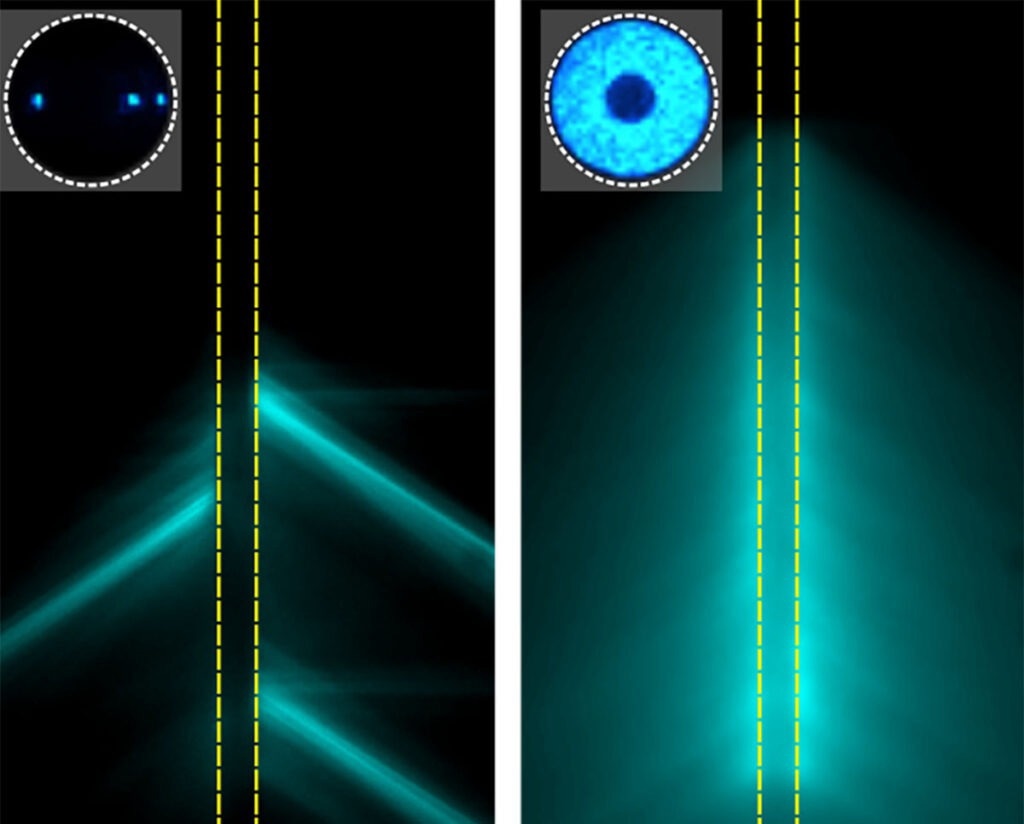Reviewed by Frances BriggsNov 5 2025
By steering beams of light through a hair-thin fiber, researchers can now control neural circuits that drive movement, fear, and decision-making.
 By laser-engraving approximately 1,000 microscopic mirrors into a single optical fiber, WashU engineers and neuroscientists have developed a hair-thin implant that can direct light to multiple deep-brain targets for neural modulation. This image shows how the fiber can be controlled down to a few nodes of light in specific directions, or even the full thousand lit nodes, as shown on the right. Image Credit: Song Hu lab/WashU.edu
By laser-engraving approximately 1,000 microscopic mirrors into a single optical fiber, WashU engineers and neuroscientists have developed a hair-thin implant that can direct light to multiple deep-brain targets for neural modulation. This image shows how the fiber can be controlled down to a few nodes of light in specific directions, or even the full thousand lit nodes, as shown on the right. Image Credit: Song Hu lab/WashU.edu
A team of researchers from Washington University in St. Louis' McKelvey School of Engineering and WashU Medicine has developed a new type of fiber-optic device that can influence neuronal activity deep within the brain.
The PRIME (Panoramically Reconfigurable IlluMinativE) fiber provides multi-site, reconfigurable optical stimulation via a single, hair-thin implant. The results were reported in Nature Neuroscience.
Fiber-optic technology has revolutionized the telecommunications sector and may ultimately do the same for brain research.
By combining fiber-based techniques with optogenetics, we can achieve deep-brain stimulation at unprecedented scale.
Song Hu, Professor, Biomedical Engineering, McKelvey School of Engineering, Washington University in St. Louis
Optical fibers drive the science of optogenetics by exploiting light-sensitive ion channels to switch neurons in the deep brain on and off. However, traditional fibers have limitations: a single fiber can only transmit light to one destination.
To understand the complex brain circuits, researchers must illuminate hundreds, if not thousands, of different points throughout the brain. Adding a thousand optical fibers would be far too intrusive.
The researchers considered what would happen if one fiber could send light in a thousand different directions. To achieve this, Hu's team, which included postdoctoral researcher and first author Shuo Yang, spearheaded the development of the PRIME technology, utilizing ultrafast laser 3D microfabrication to inscribe thousands of grating light emitters (serving as mirrors) onto a fiber the width of a human hair.
Meanwhile, Kepecs' team, which included graduate student and co-first author Keran Yang and postdoctoral senior scientist Quentin Chevy, validated the device by testing its brain manipulation approach in freely functioning animal models.
These findings represent both a significant advancement in neurotechnology and a notable breakthrough in fabrication.
We’re carving very small light emitters into very small pieces. Very small meaning tiny mirrors that are 1/100th the size of a human hair.
Shuo Yang, Study First Author and Postdoctoral Researcher, Washington University in St. Louis
The PRIME fiber connects light to neurons in several brain regions. In proof-of-concept animal investigations, Keran Yang used PRIME to stimulate activity in subregions of the superior colliculus, a hub for sensorimotor transformation, and systematically caused freezing or escape behavior based on the reconfigurable light pattern.
This kind of tool lets us ask questions that were impossible before. By precisely shaping light in both space and time, we can start to see how neighboring circuits interact and how patterns of activity across the brain give rise to behavior.
Keran Yang, Study Co-First Author and Graduate Student, Washington University in St. Louis
The researchers say the device rewrites what is experimentally possible by linking distributed neural activity to perception and action.
It brings a new level of access to probe neural circuit function.
Looking ahead, the group intends to expand PRIME into a bidirectional interface by merging optogenetics with photometry, allowing researchers to simultaneously stimulate and record brain activity.
This is just the start of an exciting journey. Our ultimate goal is to make PRIME wireless and wearable. The less cumbersome the tool, the more natural the data they can get from freely behaving subjects that are not bogged down in wires.
Song Hu, Professor, Biomedical Engineering, McKelvey School of Engineering, Washington University in St. Louis
Journal Reference:
Yang, S. et.al. (2025) Laser-engineered PRIME fiber for panoramic reconfigurable control of neural activity. Nature Neuroscience. doi.org/10.1038/s41593-025-02106-x.